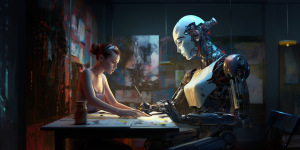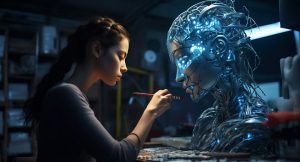Artificial intelligence (AI) has emerged as one of the most innovative driving forces within divergent arenas of industries, and perhaps one of the most compelling fronts it has impacted is within the establishment of creativity. Everybody seemed to be an artist again, with the ability of AI in creating music and art, helping to write and design. Here at Jain Software, we are not mere spectators of this revolution, but an active participant in it, changing the field dynamics by harnessing the power of AI and striving to breathe life into creativity in ways once considered unimaginable. This blog is an attempt to bring out the growing relevance of AI and how Jain Software is a part of this revolution.

It’s essential to understand the connection between AI and creativity as the former is a widely growing field.
In more general terms, creativity is defined as the power of thinking unconventionally and innovation, normally associated with the ability to produce new ideas in any domain including art, science, and technology. Nevertheless, the growth of AI technology has proven this notion to be untrue due to the avenue that technological concepts have provided to replicate, enhance and, at some occasions, surpass human imagination. AI’s role in creativity can be broadly categorized into three main areas: The three prominent types are augmentation, automation, and inspiration.
Augmentation:
AI allows improving human creativity because while machines can not create new ideas out of the blue, they can provide tools and recommendations that can help in this process. For example, giant software applications used in design can provide real-time recommendations for color combinations or layouts or even translations while allowing for quick changes to ideas. It means, for example, a program like language models can assist writers by providing the next phrases, pointing out the grammatical mistakes, or even coming up with the topics for an article.
Automation:
Some, often routine, operations in the creative processes can be and indeed are, affording help from AI tools and technologies so that more time and cerebral energy is spared for creative matters. For instance, it can recommend an appropriate background music for the given video, write captions, or select dull inlay patterns, so that designers can focus on creative work.
Inspiration:
It can be defined as the novelty aspect of AI, which simply means that an AI source can inspire other sources by coming up with totally new suggestions or ideas. The capability of creating new products or designs is one of the ways through which AI is capable of designing, for instance through generative adversarial networks (GANs) where one can develop distinct pieces of art, stories or even music. Thus, boldness of these AI-generated outputs and artistic creations can be viewed as a kind of potentiality for human creativity, as a starting point for new ideas and approaches.
AI in Visual Arts
Without any doubts, one of the most impressive analytics of AI in creativity is in the art of painting. Artificial intelligence can also consume a large number of images and artworks in order to learn styles and techniques used as well as set certain patterns in artworks. With this information AI is capable of creating art pieces on its own or helping artists to do so.
In this article, we describe how we have used AI at the Jain Software company and in particular, how we have designed tools that can assist artists in the process of creating new works. One feature that is unique to our software is the ability to draw on some of the previous works of the artist in question and propose a different approach to the work that is being done and this can be by merging two different styles of work into one entirely new style of work. Some of the benefits of technology on art include in so doing this not only aids artists to advance in their craft, but also expand the opportunities for art making.
AI in Music Composition
Music is another area where creativity and technology blend well, and using AI in music composition is another subtopic that is worth examining. It can also use its analysis abilities on the patterns in tunes then generate new patterns and compositions or help musicians create. These include OpenAI’s Massenet that can create different tracks of varying genres ranging from classical to modern music, something which a musician or music producer can collaborate with.
Jain Software integrates this technology to design intelligent musical instruments that support composers or musicians. It is capable of providing chord sequences, melodies, and even create compositions and parts on the basis of certain parameters. This is good for musicians as they are able to perform in other styles that they may not have trying before increasing the quality of their work.
Writing/Story Telling & AI
Another area where AI is widely used is writing. Today, authors can benefit from assistance that is provided by AI, and this assistance is aimed at checking grammar, style, and suggesting content. GPT-3 can write based on specific text prompts, and writers will consider it incredibly helpful in cases where they are stuck on what they are writing or need inspiration on what they should write.
In this article, I would like to tell you about how we use AI in writing softwares at Jain Software to help writers write a better content faster. Some of the solutions are designed to provide potential corrections, offer synonymous wording suggestions, or even generate an adequate piece of text based on a writer’s input. This not only improves the writing process but also frees up writers for more on the production side of the author writing process.
AI in Design
AI has a profound influence in Design, which can also be considered as a breakthrough in the evolution of AI. There are numerous design software, which can be generated using Artificial Intelligence to assist the designers in design layout, selection of color, and even complete design based on the criterion provided by the designer. These tools use algorithms that are based on learning to identify how design has to be achieved and how can it be done differently at a later date.
AI is integrated to its design tools that helps Jain Software to assist designers where they are lacking the creativity. The software can revise the current designs, provide changes for the improvement of designs, as well as design concepts and prototypes. This makes it possible for designers to make fresh concepts and get more creative within a shorter time done than if they were to start from square one.
Concerns Around Ethical Implications and a Future Outlook
Nevertheless, without any doubt, the AI application does serve as a tool to amplifier creative work and at the same time, it brings along certain ethical dilemmas. There are legitimate concerns being raised when it comes to employing AI in creative processes: issues of originality and authoring to issues of workers being replaced by machines. These are the problems that should be solved to minimize unfavorable consequences and make the use of AI in creative sectors as responsible as possible.
Of course, we at Jain Software firmly believe in the best practices of using artificial intelligence. I firmly stand in the camp that view AI as innovation enablers and not threats to the creative processes. The idea of a tool is to help and encourage the creators as well as offer new opportunities as well as improve a work in progress. We also stay as objective as possible in our AI algorithms; our AI are helpful, not horrifying and monstrous.
Now considering the years to come, the incorporation of AI into creative spaces is something that has endless possibilities. With these advancements in AI technology, experts are projecting even more complex tools that can learn, critically think as well as mimic the creativity of humans. This will provide fresh avenues for art, music, writing, and design and enable individuals in these creative fields to innovate.
Conclusion
Creative fields are also being reshaped by AI, as it supports artists, enhances creativity, and frees up time for human agents to focus on more valuable work. At Jain Software, we are in the headlight of this revolution, to invent Artificial Intelligence based tools to improve creative processes in every field. Nevertheless, there is a range of ethical issues to solve, but in general, the focus on the opportunities that AI may open to creativity is promising. With that said, this is a new practice that definitely has potential and what we will eventually see as a ‘new normal’ for artists in the future.
Through AI, not only are we strengthening creativity and improving our design and art skills but also expanding horizons for artistic work. Jain Software and its team are focused on creating industry-leading and advanced AI solutions for the creative minds to let them explore the booming territory.

